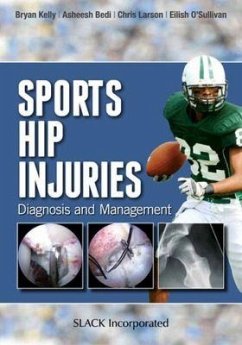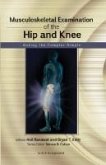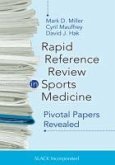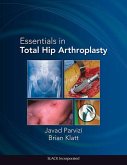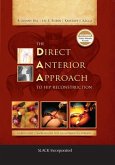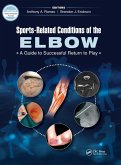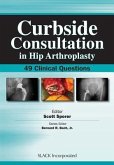- Gebundenes Buch
- Merkliste
- Auf die Merkliste
- Bewerten Bewerten
- Teilen
- Produkt teilen
- Produkterinnerung
- Produkterinnerung
In the world of sports, hip injuries among an athletic population can be very difficult to diagnose and manage.
Andere Kunden interessierten sich auch für
![Musculoskeletal Examination of the Hip and Knee Musculoskeletal Examination of the Hip and Knee]() Anil RanawatMusculoskeletal Examination of the Hip and Knee114,99 €
Anil RanawatMusculoskeletal Examination of the Hip and Knee114,99 €![Rapid Reference Review in Sports Medicine Rapid Reference Review in Sports Medicine]() Mark MillerRapid Reference Review in Sports Medicine84,99 €
Mark MillerRapid Reference Review in Sports Medicine84,99 €![Fundamentals of Revision Hip Arthroplasty Fundamentals of Revision Hip Arthroplasty]() David JacofskyFundamentals of Revision Hip Arthroplasty230,99 €
David JacofskyFundamentals of Revision Hip Arthroplasty230,99 €![Essentials in Total Hip Arthroplasty Essentials in Total Hip Arthroplasty]() Javad ParviziEssentials in Total Hip Arthroplasty260,99 €
Javad ParviziEssentials in Total Hip Arthroplasty260,99 €![The Direct Anterior Approach to Hip Reconstruction The Direct Anterior Approach to Hip Reconstruction]() B. BalThe Direct Anterior Approach to Hip Reconstruction269,99 €
B. BalThe Direct Anterior Approach to Hip Reconstruction269,99 €![Sports-Related Conditions of the Elbow Sports-Related Conditions of the Elbow]() Anthony RomeoSports-Related Conditions of the Elbow265,99 €
Anthony RomeoSports-Related Conditions of the Elbow265,99 €![Curbside Consultation in Hip Arthroplasty Curbside Consultation in Hip Arthroplasty]() Scott SporerCurbside Consultation in Hip Arthroplasty158,99 €
Scott SporerCurbside Consultation in Hip Arthroplasty158,99 €-
-
-
In the world of sports, hip injuries among an athletic population can be very difficult to diagnose and manage.
Hinweis: Dieser Artikel kann nur an eine deutsche Lieferadresse ausgeliefert werden.
Hinweis: Dieser Artikel kann nur an eine deutsche Lieferadresse ausgeliefert werden.
Produktdetails
- Produktdetails
- Verlag: CRC Press
- Seitenzahl: 342
- Erscheinungstermin: 15. April 2015
- Englisch
- Abmessung: 260mm x 183mm x 23mm
- Gewicht: 839g
- ISBN-13: 9781617110467
- ISBN-10: 1617110469
- Artikelnr.: 34389888
- Herstellerkennzeichnung
- Libri GmbH
- Europaallee 1
- 36244 Bad Hersfeld
- gpsr@libri.de
- Verlag: CRC Press
- Seitenzahl: 342
- Erscheinungstermin: 15. April 2015
- Englisch
- Abmessung: 260mm x 183mm x 23mm
- Gewicht: 839g
- ISBN-13: 9781617110467
- ISBN-10: 1617110469
- Artikelnr.: 34389888
- Herstellerkennzeichnung
- Libri GmbH
- Europaallee 1
- 36244 Bad Hersfeld
- gpsr@libri.de
Bryan T. Kelly, MD, is a specialist in sports medicine injuries and arthroscopic and open surgi- cal management of nonarthritic disorders around the hip. He has a faculty appointment at Weill Cornell Medical College and medical staff appointments at Hospital for Special Surgery and NewYork-Presbyterian Hospital. He cares for several sports teams, serving as the Associate Team Physician for the New York Giants and the New York Red Bull's Major League Soccer team, as well as the Team Consult for hip injuries for the New Jersey Nets and several collegiate teams in the tri-state region. Following his residency at Hospital for Special Surgery in 2001, Dr. Kelly completed a two-year fellowship there, specializing in Sports Medicine and Shoulder Surgery. He then completed a fellowship in Hip Sports Injuries and Arthroscopy at the University of Pittsburgh Medical Center, Center for Sports Medicine, under the direction of Dr. Marc J. Philippon, MD. Prior to starting his practice, Dr. Kelly also completed an AO International Traveling Fellowship, where he spent time with Dr. Herbert Resch at the Landeskliniken Hospital in Salzburg, Austria, as well as with Professor Reinhold Ganz in Bern, Switzerland, studying advanced techniques in open management of hip and shoulder injuries. Dr. Kelly currently serves as the Chief of the Hip Preservation Service, which is designed to provide multidisciplinary care for patients at all levels with hip injuries. He has a broad range of both clinical and basic science research interests, including the development of a clinical outcomes registry; biomechanical studies evaluating conflict patterns in femoroacetabular impingement and techniques in labral refixation; the development of synthetic scaffolds for labral reconstruction and cartilage injuries in the hip; and the development of novel surgical techniques for managing soft tissue injuries around the hip joint. He has authored over 125 scientific publications, chapters, review articles, and books. Asheesh Bedi, MD, is the Harold and Helen W. Gehring Early Career Professor of Orthopaedic Surgery at the University of Michigan and MedSport Program. He is also an adjunct assistant professor at Hospital for Special Surgery Center for Hip Preservation. He is a team physician for the University of Michigan and Eastern Michigan University and a consultant for the National Football League and National Hockey League Players' Association, and specializes in both arthroscopic and open surgery for athletic injuries of the shoulder, elbow, hip, and knee. Dr. Bedi completed his undergraduate training at Northwestern University, where he graduated summa cum laude. He graduated from the University of Michigan Medical School with Alpha Omega Alpha recognition, and remained in Ann Arbor to pursue residency training in Orthopaedic Surgery at the University of Michigan. Following his training, Dr. Bedi completed an extended fellowship in sports medicine, shoulder surgery, and hip preservation at Hospital for Special Surgery and Weill Cornell Medical College in New York. He received the Leonard Marmor Outstanding Orthopaedic Resident Award, and the Hospital for Special Surgery Philip D. Wilson Award for Excellence in both 2008 and 2009 for his efforts in orthopaedic research and tendon-bone heal- ing studies with Dr. Scott Rodeo. Dr. Bedi is the winner of the 2010 and 2014 Neer Award of the American Shoulder and Elbow Surgeons and a recipient of the 2010 Cabaud Award from the American Orthopaedic Society for Sports Medicine. He has authored over 200 articles, chapters, and peer-reviewed publications on shoulder, elbow, knee, and hip injuries in athletes. Christopher M. Larson, MD, is a sports medicine fellowship-trained surgeon who specializes in hip arthroscopy, treatment of femoroacetabular impingement, anterior cruciate ligament reconstruction, and proximal hamstring repairs. After completing undergraduate studies (summa cum laude) and medical school (Alpha Omega Alpha honors) at the University of Minnesota, Dr. Larson performed his residency at the University of North Carolina, receiving the resident research and teaching award, and sports medicine fellowship at the Minneapolis Sports Medicine Center. He has performed over 3000 hip arthroscopies/femoroacetabular impingement corrective procedures and regularly lectures nationally and internationally. He is a master instructor for the Arthroscopy Association of North America, co-chairman for the American Academy of Orthopaedic Surgery Hip Preservation Course, and has published over 100 peer-reviewed articles and book chapters regarding hip and knee sports medicine. Dr. Larson is currently a Team Physician for the Minnesota Wild (National Hockey League), and served as Team Physician for the Minnesota Vikings (National Football League) from 2007 to 2011. He is Program Director for the Minnesota Orthopedic Sports Medicine Institute/Fairview Orthopaedic Sports Fellowship program and is certified in orthopedic sports medicine by the American Academy of Orthopaedic Surgeons. Eilish O'Sullivan, PT, DPT, OCS, is a physical therapist board certified in orthopedics, specializing in hip and core muscle injuries. She currently serves as Clinical Care Coordinator for Dr. Bryan Kelly, overseeing the clinical care of his patients and return to play for the athletes. She also maintains a small clinical practice, treating patients with hip and core muscle injuries. Dr. O'Sullivan graduated from Princeton University with a bachelor's degree in psychology. She went on to Massachusetts General Hospital Institute of Health Professions to obtain her Doctor of Physical Therapy degree, followed by a year-long internship at Spaulding Rehabilitation Hospital. She then went on to Hospital for Special Surgery, where she worked at the Sports Rehabilitation and Performance Center, and lectured at a number of continuing education courses on the topics of hip rehabilitation and core stabilization. Dr. Sullivan is a member of the Sports Section of the American Physical Therapy Association. Her research interests include hip biomechanics and return to sport following hip injury, and she has published on both of these topics.
Dedication About the Editors Contributing Authors Foreword by Russell F.
Warren, MD Introduction Section I Basic Injury Patterns Chapter 1
Anatomical Considerations and Clinical Examination Chapter 2
Femoroacetabular Impingement: I. Pathoanatomy, Clinical Evaluation, and
Arthroscopic Treatment Strategies Chapter 3 Femoroacetabular Impingement:
II. Open Treatment Strategies and Outcomes in Femoroacetabular Impingement
Surgery Chapter 4 Dysplasia and Instability Chapter 5 Traumatic Hip
Subluxation/Dislocation and Femoroacetabular Impingement-Induced
Instability Chapter 6 Anterior Soft Tissue Injuries of the Hip: Hip Flexor,
Iliopsoas, and Subspine Impingement Chapter 7 Medial Soft Tissue Injuries
of the Hip: Adductor Strains and Athletic Pubalgia/Core Muscle Injury
Chapter 8 Posterior Soft Tissue Injuries of the Hip: Hamstring Chapter 9
Lateral Soft Tissue Injuries of the Hip: Abductors and Iliotibial Band
Syndrome Chapter 10 Nerve Compression Injuries About the Hip and Deep
Gluteal Syndrome Chapter 11 Stress Fractures of the Hip and Pelvis Section
II Sport-Specific Injuries Chapter 12 The Contact Athlete: Football and
Rugby Chapter 13 The Pivoting Athlete: Hockey, Soccer, Lacrosse,
Basketball, Chapter 14 The Overhead Athlete: Baseball, Volleyball, and
Tennis Chapter 15 The Endurance Athlete: Runners, Cyclists, Rowers, and
Triathletes Chapter 16 The Hypermobile Athlete: Dancers, Cheerleaders,
Chapter 17 Sport-Specific Rehabilitation Guidelines Chapter 18 Outcomes in
Return to Sport Financial Disclosures Index
Warren, MD Introduction Section I Basic Injury Patterns Chapter 1
Anatomical Considerations and Clinical Examination Chapter 2
Femoroacetabular Impingement: I. Pathoanatomy, Clinical Evaluation, and
Arthroscopic Treatment Strategies Chapter 3 Femoroacetabular Impingement:
II. Open Treatment Strategies and Outcomes in Femoroacetabular Impingement
Surgery Chapter 4 Dysplasia and Instability Chapter 5 Traumatic Hip
Subluxation/Dislocation and Femoroacetabular Impingement-Induced
Instability Chapter 6 Anterior Soft Tissue Injuries of the Hip: Hip Flexor,
Iliopsoas, and Subspine Impingement Chapter 7 Medial Soft Tissue Injuries
of the Hip: Adductor Strains and Athletic Pubalgia/Core Muscle Injury
Chapter 8 Posterior Soft Tissue Injuries of the Hip: Hamstring Chapter 9
Lateral Soft Tissue Injuries of the Hip: Abductors and Iliotibial Band
Syndrome Chapter 10 Nerve Compression Injuries About the Hip and Deep
Gluteal Syndrome Chapter 11 Stress Fractures of the Hip and Pelvis Section
II Sport-Specific Injuries Chapter 12 The Contact Athlete: Football and
Rugby Chapter 13 The Pivoting Athlete: Hockey, Soccer, Lacrosse,
Basketball, Chapter 14 The Overhead Athlete: Baseball, Volleyball, and
Tennis Chapter 15 The Endurance Athlete: Runners, Cyclists, Rowers, and
Triathletes Chapter 16 The Hypermobile Athlete: Dancers, Cheerleaders,
Chapter 17 Sport-Specific Rehabilitation Guidelines Chapter 18 Outcomes in
Return to Sport Financial Disclosures Index
Dedication About the Editors Contributing Authors Foreword by Russell F.
Warren, MD Introduction Section I Basic Injury Patterns Chapter 1
Anatomical Considerations and Clinical Examination Chapter 2
Femoroacetabular Impingement: I. Pathoanatomy, Clinical Evaluation, and
Arthroscopic Treatment Strategies Chapter 3 Femoroacetabular Impingement:
II. Open Treatment Strategies and Outcomes in Femoroacetabular Impingement
Surgery Chapter 4 Dysplasia and Instability Chapter 5 Traumatic Hip
Subluxation/Dislocation and Femoroacetabular Impingement-Induced
Instability Chapter 6 Anterior Soft Tissue Injuries of the Hip: Hip Flexor,
Iliopsoas, and Subspine Impingement Chapter 7 Medial Soft Tissue Injuries
of the Hip: Adductor Strains and Athletic Pubalgia/Core Muscle Injury
Chapter 8 Posterior Soft Tissue Injuries of the Hip: Hamstring Chapter 9
Lateral Soft Tissue Injuries of the Hip: Abductors and Iliotibial Band
Syndrome Chapter 10 Nerve Compression Injuries About the Hip and Deep
Gluteal Syndrome Chapter 11 Stress Fractures of the Hip and Pelvis Section
II Sport-Specific Injuries Chapter 12 The Contact Athlete: Football and
Rugby Chapter 13 The Pivoting Athlete: Hockey, Soccer, Lacrosse,
Basketball, Chapter 14 The Overhead Athlete: Baseball, Volleyball, and
Tennis Chapter 15 The Endurance Athlete: Runners, Cyclists, Rowers, and
Triathletes Chapter 16 The Hypermobile Athlete: Dancers, Cheerleaders,
Chapter 17 Sport-Specific Rehabilitation Guidelines Chapter 18 Outcomes in
Return to Sport Financial Disclosures Index
Warren, MD Introduction Section I Basic Injury Patterns Chapter 1
Anatomical Considerations and Clinical Examination Chapter 2
Femoroacetabular Impingement: I. Pathoanatomy, Clinical Evaluation, and
Arthroscopic Treatment Strategies Chapter 3 Femoroacetabular Impingement:
II. Open Treatment Strategies and Outcomes in Femoroacetabular Impingement
Surgery Chapter 4 Dysplasia and Instability Chapter 5 Traumatic Hip
Subluxation/Dislocation and Femoroacetabular Impingement-Induced
Instability Chapter 6 Anterior Soft Tissue Injuries of the Hip: Hip Flexor,
Iliopsoas, and Subspine Impingement Chapter 7 Medial Soft Tissue Injuries
of the Hip: Adductor Strains and Athletic Pubalgia/Core Muscle Injury
Chapter 8 Posterior Soft Tissue Injuries of the Hip: Hamstring Chapter 9
Lateral Soft Tissue Injuries of the Hip: Abductors and Iliotibial Band
Syndrome Chapter 10 Nerve Compression Injuries About the Hip and Deep
Gluteal Syndrome Chapter 11 Stress Fractures of the Hip and Pelvis Section
II Sport-Specific Injuries Chapter 12 The Contact Athlete: Football and
Rugby Chapter 13 The Pivoting Athlete: Hockey, Soccer, Lacrosse,
Basketball, Chapter 14 The Overhead Athlete: Baseball, Volleyball, and
Tennis Chapter 15 The Endurance Athlete: Runners, Cyclists, Rowers, and
Triathletes Chapter 16 The Hypermobile Athlete: Dancers, Cheerleaders,
Chapter 17 Sport-Specific Rehabilitation Guidelines Chapter 18 Outcomes in
Return to Sport Financial Disclosures Index

